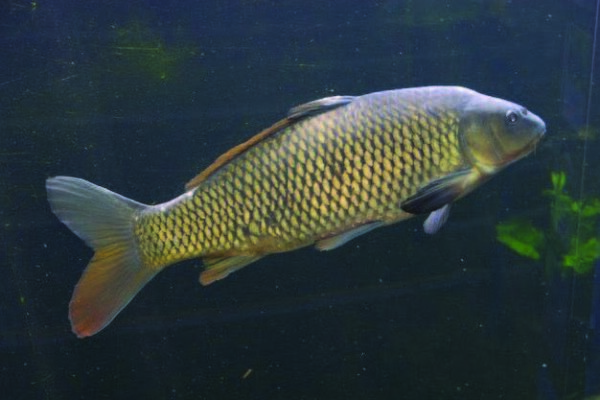Common Carp

Species at a Glance
The common carp (Cyprinus carpio) is one of the oldest species to have been introduced globally and is present on every continent except Antarctica. It is considered among the world’s worst invasive species and is the most frequently reported nuisance fish in the United States.
Species Description
The common carp is a voracious, omnivorous fish and one of the largest members of the minnow family, Cyprinidae. It is long-lived with a lifespan of up to 50 years. Its body is heavy and stout, averaging 25-55 cm (10-22 in) in length and weighing 1-10 pounds, although some can reach up to 80 pounds! Color varies from bronze, brassy, or yellow with large scales usually outlined in black. The head is short with a rounded snout, a toothless sucker-like mouth, and two pairs of barbels on each side of the upper jaw. Varieties of common carp include mirror carp, leather carp, and koi, which is popular in small ponds and water gardens.
Native & Introduced Ranges
While native to areas of Europe and Asia, mainly along the Danube River drainage system, current native populations of common carp are questionable and probably limited to a few areas. It’s unclear exactly when the species was introduced into the United States, but most sources suggest that it was introduced in the 1800s as a food and game fish. By 1885, the U.S. Fish Commission was actively stocking lakes and rivers throughout the country with common carp, and it is now prevalent throughout the entire United States.
Biology & Spread
Common carp are migratory, and once introduced will spread naturally through waterway connections to other bodies of water to spawn. Spawning begins in late April and continues into June with females laying between 100,000 and 500,000 eggs. Young common carp can resemble baitfish, so anglers present another vector of spread by using them as bait.
Habitat
The common carp is tolerant of cold winter periods and low oxygen concentration ns. It is most often found in manmade impoundments, lakes, ponds, and turbid sluggish streams receiving sewage or agricultural runoff, and is less abundant in clear waters or streams with a high gradient. It also inhabits brackish-water estuaries, backwaters, bays, and shallow water during spring spawning.
Impacts
Introduction of the common carp causes dramatic ecological disruptions at both the community and ecosystem level. The common carp is omnivorous, feeding on benthic aquatic organisms such as insect larvae, worms, mollusks and zooplankton as well as the stalks, seeds, and leaves of aquatic plants. This foraging behavior increases the turbidity of the water, which releases phosphorous and increases algae growth. This foraging also prevents the growth of native aquatic plants and ultimately has a negative impact on water quality.
Prevention & Control
Control and eradication methods have traditionally focused on using non-specific poisons, constructing electric or physical barriers, or harvesting from small controlled systems. These methods have been short-lived and costly, yielding only limited success. Therefore, prevention remains the best and most cost effective line of defense against additional introductions of the common carp.
Techniques to prevent the spread of common carp and other aquatic invasive species include checking for and removing any plants, mud, and debris from boats, trailers, clothing, and equipment before leaving a water body; draining water from bait buckets, bilges, and live wells before transporting to new areas; cleaning all equipment: or letting gear and equipment dry for at least five days. Since young common carp can resemble baitfish, it’s important to know how to identify them, and to never use common carp as bait.
References:
Flajshans, M. and Hulata, G. Common Carp-Cyprinus carpio. Genimpact final scientific report
University of South Bohemia, Czech Republic and Agricultural Research Organization, Israel.
Miller, S.A. and Crowl, T.A. 2005. Effects of common carp (Cyprinus carpio) on macrophytes and
invertebrate communities in a shallow lake. Freshwater Biology. 51 (1): 85-94.
Nico, L., E. Maynard, P.J. Schofield, M. Cannister, J. Larson, A. Fusaro, and M. Neilson. 2015.
Cyprinus carpio Linnaeus, 1758: U.S. Geological Survey, Nonindigenous Aquatic Species Database,
Gainesville, FL,
Stuart, I.G., Williams, A. McKenzie, J., and Holt, T. 2006. Managing a Migratory Pest Species: A
Selective Trap for Common Carp. North American Journal of Fisheries Management. 26 (4): 888-893



